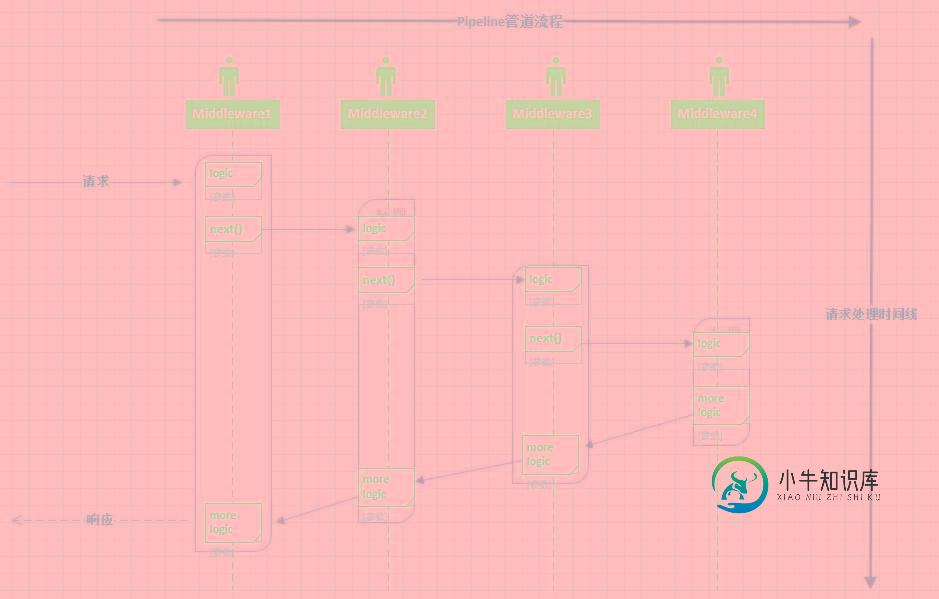ASP.NET Core Middleware的实现方法详解
概念
ASP.NET Core Middleware是在应用程序处理管道pipeline中用于处理请求和操作响应的组件。
每个组件:
- 在pipeline中判断是否将请求传递给下一个组件
- 在处理管道的下个组件执行之前和之后执行一些工作, HttpContxt对象能跨域请求、响应的执行周期
特性和行为
ASP.NET Core处理管道由一系列请求委托组成,一环接一环的被调用, 下面给出自己绘制的Middleware pipeline流程图:

从上图可以看出,请求自进入处理管道,经历了四个中间件,每个中间件都包含后续紧邻中间件 执行委托(next)的引用,同时每个中间件在交棒之前和交棒之后可以自行决定参与一些Http请求和响应的逻辑处理。
每个中间件还可以决定不将请求转发给下一个委托,这称为请求管道的短路(短路是有必要的,某些专有中间件比如 StaticFileMiddleware 可以在完成功能之后,避免请求被转发到其他动态处理过程)。
源码实现
观察一个标准的中间件代码的写法和用法:
using System.Threading.Tasks;
using Alyio.AspNetCore.ApiMessages;
using Gridsum.WebDissector.Common;
using Microsoft.AspNetCore.Http;
namespace Gridsum.WebDissector
{
sealed class AuthorizationMiddleware
{
private readonly RequestDelegate _next; // 下一个中间件执行委托的引用
public AuthorizationMiddleware(RequestDelegate next)
{
_next = next;
}
public Task Invoke(HttpContext context) // 贯穿始终的HttpContext对象
{
if (context.Request.Path.Value.StartsWith("/api/"))
{
return _next(context);
}
if (context.User.Identity.IsAuthenticated && context.User().DisallowBrowseWebsite)
{
throw new ForbiddenMessage("You are not allow to browse the website.");
}
return _next(context);
}
}
}
public static IApplicationBuilder UserAuthorization(this IApplicationBuilder app)
{
return app.UseMiddleware<AuthorizationMiddleware>();
}
// 启用该中间件,也就是注册该中间件
app.UserAuthorization();
标准的中间件使用方式是如此简单明了,带着几个问题探究一下源码实现
(1).中间件传参是怎样完成的: app.UseMiddleware<Authorization>(AuthOption); 我们传参的时候,为什么能自动注入中间件构造函数非第1个参数
(2).编写中间件的时候,为什么必须要定义特定的 Invoke/InvokeAsync 函数?
(3).设定中间件的顺序很重要,中间件的嵌套顺序是怎么确定的 ?
思考以上标准中间件的行为: 输入下一个中间件的执行委托Next, 定义当前中间件的执行委托Invoke/InvokeAsync;
每个中间件完成了 Func<RequestDelegate,RequestDelegate>这样的行为;
通过参数next与下一个中间件的执行委托Invoke/InvokeAsync 建立"链式"关系。
public delegate Task RequestDelegate(HttpContext context);
//-----------------节选自 Microsoft.AspNetCore.Builder.UseMiddlewareExtensions------------------
/// <summary>
/// Adds a middleware type to the application's request pipeline.
/// </summary>
/// <typeparam name="TMiddleware">The middleware type.</typeparam>
/// <param name="app">The <see cref="IApplicationBuilder"/> instance.</param>
/// <param name="args">The arguments to pass to the middleware type instance's constructor.</param>
/// <returns>The <see cref="IApplicationBuilder"/> instance.</returns>
public static IApplicationBuilder UseMiddleware<TMiddleware>(this IApplicationBuilder app, params object[] args)
{
return app.UseMiddleware(typeof(TMiddleware), args);
}
/// <summary>
/// Adds a middleware type to the application's request pipeline.
/// </summary>
/// <param name="app">The <see cref="IApplicationBuilder"/> instance.</param>
/// <param name="middleware">The middleware type.</param>
/// <param name="args">The arguments to pass to the middleware type instance's constructor.</param>
/// <returns>The <see cref="IApplicationBuilder"/> instance.</returns>
public static IApplicationBuilder UseMiddleware(this IApplicationBuilder app, Type middleware, params object[] args)
{
if (typeof(IMiddleware).GetTypeInfo().IsAssignableFrom(middleware.GetTypeInfo()))
{
// IMiddleware doesn't support passing args directly since it's
// activated from the container
if (args.Length > 0)
{
throw new NotSupportedException(Resources.FormatException_UseMiddlewareExplicitArgumentsNotSupported(typeof(IMiddleware)));
}
return UseMiddlewareInterface(app, middleware);
}
var applicationServices = app.ApplicationServices;
return app.Use(next =>
{
var methods = middleware.GetMethods(BindingFlags.Instance | BindingFlags.Public); // 执行委托名称被限制为Invoke/InvokeAsync
var invokeMethods = methods.Where(m =>
string.Equals(m.Name, InvokeMethodName, StringComparison.Ordinal)
|| string.Equals(m.Name, InvokeAsyncMethodName, StringComparison.Ordinal)
).ToArray();
if (invokeMethods.Length > 1)
{
throw new InvalidOperationException(Resources.FormatException_UseMiddleMutlipleInvokes(InvokeMethodName, InvokeAsyncMethodName));
}
if (invokeMethods.Length == 0)
{
throw new InvalidOperationException(Resources.FormatException_UseMiddlewareNoInvokeMethod(InvokeMethodName, InvokeAsyncMethodName, middleware));
}
var methodInfo = invokeMethods[0];
if (!typeof(Task).IsAssignableFrom(methodInfo.ReturnType))
{
throw new InvalidOperationException(Resources.FormatException_UseMiddlewareNonTaskReturnType(InvokeMethodName, InvokeAsyncMethodName, nameof(Task)));
}
var parameters = methodInfo.GetParameters();
if (parameters.Length == 0 || parameters[0].ParameterType != typeof(HttpContext))
{
throw new InvalidOperationException(Resources.FormatException_UseMiddlewareNoParameters(InvokeMethodName, InvokeAsyncMethodName, nameof(HttpContext)));
}
var ctorArgs = new object[args.Length + 1];
ctorArgs[0] = next;
Array.Copy(args, 0, ctorArgs, 1, args.Length); // 通过反射形成中间件实例的时候,构造函数第一个参数被指定为 下一个中间件的执行委托 var instance = ActivatorUtilities.CreateInstance(app.ApplicationServices, middleware, ctorArgs);
if (parameters.Length == 1)
{
return (RequestDelegate)methodInfo.CreateDelegate(typeof(RequestDelegate), instance);
}
// 当前执行委托除了可指定HttpContext参数以外, 还可以注入更多的依赖参数
var factory = Compile<object>(methodInfo, parameters);
return context =>
{
var serviceProvider = context.RequestServices ?? applicationServices;
if (serviceProvider == null)
{
throw new InvalidOperationException(Resources.FormatException_UseMiddlewareIServiceProviderNotAvailable(nameof(IServiceProvider)));
}
return factory(instance, context, serviceProvider);
};
});
}
//-------------------节选自 Microsoft.AspNetCore.Builder.Internal.ApplicationBuilder-------------------
private readonly IList<Func<RequestDelegate, RequestDelegate>> _components = new List<Func<RequestDelegate, RequestDelegate>>();
publicIApplicationBuilder Use(Func<RequestDelegate,RequestDelegate>middleware)
{
this._components.Add(middleware);
return this;
}
public RequestDelegate Build()
{
RequestDelegate app = context =>
{
context.Response.StatusCode = 404;
return Task.CompletedTask;
};
foreach (var component in _components.Reverse())
{
app = component(app);
}
return app;
}
通过以上代码我们可以看出:
- 注册中间件的过程实际上,是给一个 Type= List<Func<RequestDelegate, RequestDelegate>> 的容器依次添加元素的过程;
- 容器中每个元素对应每个中间件的行为委托Func<RequestDelegate, RequestDelegate> , 这个行为委托包含2个关键行为:输入下一个中间件的执行委托next:RequestDelegate, 完成当前中间件的Invoke函数: RequestDelegate;
- 通过build方法完成前后中间件的链式传值关系

分析源码:回答上面的问题:
- 使用反射构造中间件的时候,第一个参数Array[0] 是下一个中间件的执行委托
- 当前中间件执行委托 函数名称被限制为: Invoke/InvokeAsync, 函数支持传入除HttpContext之外的参数
- 按照代码顺序添加进入 _components容器, 通过后一个中间件的执行委托 -----(指向)----> 前一个中间件的输入执行委托建立链式关系。
附:非标准中间件的用法
短路中间件、 分叉中间件
整个处理管道的形成,存在一些管道分叉或者临时插入中间件的行为,一些重要方法可供使用
- Use方法是一个注册中间件的简便写法
- Run方法是一个约定,一些中间件使用Run方法来完成管道的结尾
- Map扩展方法:请求满足指定路径,将会执行分叉管道,强调满足 path
- MapWhen方法:HttpContext满足条件,将会执行分叉管道:
- UseWhen方法:选择性的注入中间件

总结
以上就是这篇文章的全部内容了,希望本文的内容对大家的学习或者工作具有一定的参考学习价值,如果有疑问大家可以留言交流,谢谢大家对小牛知识库的支持。
-
本文向大家介绍Python_LDA实现方法详解,包括了Python_LDA实现方法详解的使用技巧和注意事项,需要的朋友参考一下 LDA(Latent Dirichlet allocation)模型是一种常用而用途广泛地概率主题模型。其实现一般通过Variational inference和Gibbs Samping实现。作者在提出LDA模型时给出了其变分推理的C源码(后续贴出C++改编的类),这里
-
本文向大家介绍js实现跨域的方法实例详解,包括了js实现跨域的方法实例详解的使用技巧和注意事项,需要的朋友参考一下 本文实例讲述了js实现跨域的方法。分享给大家供大家参考。具体分析如下: 由于同源策略的限制,XMLHttpRequest只允许请求当前源(包含域名、协议、端口)的资源。 json与jsonp的区别: JSON是一种数据交换格式,而JSONP是一种依靠开发人员创造出的一种非官方跨域数据
-
本文向大家介绍Python实现堆排序的方法详解,包括了Python实现堆排序的方法详解的使用技巧和注意事项,需要的朋友参考一下 本文实例讲述了Python实现堆排序的方法。分享给大家供大家参考,具体如下: 堆排序作是基本排序方法的一种,类似于合并排序而不像插入排序,它的运行时间为O(nlogn),像插入排序而不像合并排序,它是一种原地排序算法,除了输入数组以外只占用常数个元素空间。 堆(定义):(
-
本文向大家介绍jQuery ready方法实现原理详解,包括了jQuery ready方法实现原理详解的使用技巧和注意事项,需要的朋友参考一下 今天闲来无事研究研究jQuery.ready()的内部实现,看JQ的源码一头雾水,由于自己很菜了,于是翻了翻牛人的播客,讲述详细,收获颇多。 先普及一下jquery.ready()和window.onload,window.onload事件是在页面所有
-
本文向大家介绍D3.js实现饼状图的方法详解,包括了D3.js实现饼状图的方法详解的使用技巧和注意事项,需要的朋友参考一下 前言 小编在之前已经跟大家分享过关于怎样用柱状图和折线图这两种基本图表。这两种图表都是有坐标轴的,现在来说一种没有坐标轴的图表——饼图。 饼状图实现 还是和之前一样,我们先把简单的画图框架搭起来,添加SVG画布。但是这里需要注意的是,为了方便后面画饼图上的弧形,我们把组合这些
-
本文向大家介绍D3.js实现折线图的方法详解,包括了D3.js实现折线图的方法详解的使用技巧和注意事项,需要的朋友参考一下 前言 D3.js是一个帮助开发者操纵基于数据的文档的JavaScript类库,在《D3.js实现柱状图的方法详解》中已经给大家介绍过如何用D3.js来实现一个简单的柱状图了,今天我们来学习用D3.js来实现折线图,感兴趣的朋友们下面来一起看看吧。 折线图由坐标轴、线条和点组成

